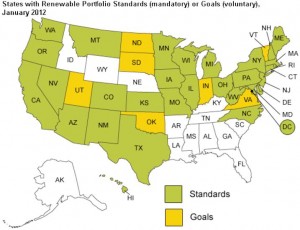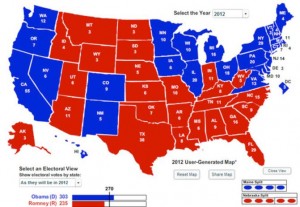What are Renewable Portfolio Standards?
A Renewable Portfolio Standard (RPS), also known as Renewable Electricity Standard or a Renewable Energy Standard, places an obligation on electricity supply companies to source a specified proportion of their electricity sales from eligible renewable energy sources. These RPS programs were created to promote the development of renewable generation technologies such as wind, solar, biomass, landfill gas, and others in order to gradually decrease the dependence on non-renewable energy such as coal and natural gas. By forcing energy supply companies to source a given percentage of their sales from renewable sources, a market demand for that power is enhanced or created.[1]
In the USA, Renewable Portfolio Standard’s are assigned and regulated by the individual states. Most states with RPS programs have associated Renewable Energy Certificate (REC) trading programs. RECs provide a mechanism by which to track the amount of renewable power being sold and to financially reward eligible power producers. For each unit of power that an eligible producer generates, a certificate or credit is issued. These can then be sold either in conjunction with the underlying power or separately to energy supply companies. A market exists for RECs because energy supply companies are required to redeem certificates equal to their obligation under the RPS program. Some state programs, in order to promote specific renewable technology types, apply a credit multiplier by which a MWh of electricity produced by a particular technology receives more than one REC. For example, a wind multiplier of 3 means that one MWh of electricity produced with wind technology provides the producer of that electricity with 3 certificates.[1][2]
In the United States, 30 states (including D.C.) currently (as of January 2012) have mandatory renewable portfolio standards and 7 have renewable portfolio goals.[2] Thirteen states however have neither mandatory or goal renewable portfolio standards as is seen in Figure 1. I found it interesting to compare the map of the States with RPS’s to the electoral map of 2012. Interestingly enough I noticed that the states without any renewable portfolio standards or goals ended up being Republican states in this past election.
Figure 1.
http://www.examiner.com/article/an-updated-look-at-the-2012-electoral-college-map-with-polls-13
Figure 3.
http://www.windpoweringamerica.gov/pdfs/wind_maps/installed_capacity_2009.pdf
A few examples of wind energy values of various state’s RPS:
Texas: “The original standard calls for 2,000 megawatts (MW) of new renewable energy capacity, in addition to the 880 MW of existing renewable energy capacity, to be installed in Texas by 2009. In August 2005, the Texas legislature passed SB 20, which increased the new capacity requirement to 5,000 MW (with a goal of 500 MW from non-wind resources) by 2015, and set a goal of 10,000 MW by 2025.” [4] In 2005, Texas passed an RPS that would require that by 2015 4,500 MW of energy would have to be produced solely from wind energy. According to Figure 3 it is seen that Texas has almost quadrupled their energy standard requirement for 2009 of 2,000 MW and they have also almost reached their 2015 goal six years in advance.
Massachusetts: “The RPS specifies that 1 percent of electricity be generated from renewable sources in 2003, with the percentage increasing by 0.5 percent per year through 2009. Thereafter, the annual percentage increase is 1 percent per year, until suspended by the Massachusetts Division of Energy Resources (DOER).”[5] As of today Massachusetts produces 61 MW of wind energy and has set their goal to 2,000 MW of wind energy to be produced per year by 2020. [6]
New York: New York State has adopted an RPS plan called High Sheldon part of the controlling company Main Tier/Large Scale Generators. Through seven solicitations, the Main Tier has 56 active projects under contract totaling 1,842 MW of new renewable capacity. Main Tier projects include: 11 Landfill Gas Projects totaling 61.7 MW, 3 Biomass Projects totaling 74.3 MW, 25 Hydroelectric Projects totaling 51.3 MW, 17 Wind Projects totaling 1,654.2 MW. The power generated from these 56 projects is expected to provide enough clean power for nearly 683,000 homes per year. New York’s Renewable Portfolio Standard is significantly reliant upon wind energy making up about 89% of the 1,842 MW of new renewable capacity. [7][8]
International RPS example:
China: The government’s current plan calls for 300 GW of hydro-power, 150 GW of wind power, 30 GW of biomass power, and 20 GW of solar PV, for a total of 500 GW of renewable power capacity by 2020. This would be almost one-third of China’s expected total power capacity of 1600 GW by 2020. Wind power is the second most used source of renewable energy in China after hydro-power. [9]
I think that it is evident that public policy has a huge impact on the growth of wind energy as well as any other form of renewable energy. More specifically it is seen that an individual state’s Renewable Portfolio Standards and Goals whether they are mandatory or voluntary are one of the main reasons for the increase in the rate of reliance on renewable energy in a state as opposed to non-renewable energy resources such as coal and natural gas. Public Policy in the USA as well as in international countries play a significant role in the needed reform of energy sources.
Citations
- http://mjbeck.emtoolbox.com/?page=Renewable_Portfolio_Standards#Renewable
- http://mjbeck.emtoolbox.com/?page=Renewable_Portfolio_Standards#stateReportInfo
- www.eia.gov/todayinenergy/detail.cfm?id=8870
- www.ucsusa.org/assets/documents/clean_energy/texas.pdf
- http://www.mass.gov/eea/grants-and-tech-assistance/guidance-technical-assistance/agencies-and-divisions/doer/renewable-energy-snapshot.html
- http://www.mass.gov/eea/docs/doer/renewables/installed-solwind.pdf
- http://www.dsireusa.org/incentives/incentive.cfm?Incentive_Code=NY03R&re=0&ee=0
- http://www.nyserda.ny.gov/en/Program-Planning/Renewable-Portfolio-Standard.aspx#maintier
- http://www.renewableenergyworld.com/rea/news/article/2010/07/renewable-energy-policy-update-for-china



One Comment
msqmota posted on December 10, 2012 at 11:27 am
I’ve read in an article that the massive deployment of wind turbines across the world has been driven mainly by public policy support. I also research more specific about European countries and I found that countries like Spain, Portugal, Germany or Ireland e mostly relied on feed-in tariffs for wind energy projects. I agree with you when you say that “public Policy in the USA as well as in international countries play a significant role in the needed reform of energy sources”.